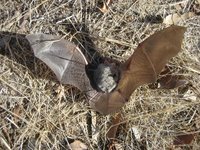 Jan and I were on the farm last week and one evening did a bit of spotlighting through some of the White Box country up in the hills, looking for nocturnal birds and tree dwelling animals. We came across two Common Brushtail Possums (Tichosurus vulpecula) in different spots, which was a bit of a thrill given it is so dry … and we’d never seen them on our place before. These are the same species of possum that are in plague proportion following their introduction to New Zealand and the locals have found it necessary to introduce programs to keep numbers in check.
Jan and I were on the farm last week and one evening did a bit of spotlighting through some of the White Box country up in the hills, looking for nocturnal birds and tree dwelling animals. We came across two Common Brushtail Possums (Tichosurus vulpecula) in different spots, which was a bit of a thrill given it is so dry … and we’d never seen them on our place before. These are the same species of possum that are in plague proportion following their introduction to New Zealand and the locals have found it necessary to introduce programs to keep numbers in check.At about 2 am that same night we were woken by the scratching and muffled squealing of a small bat that had managed to get itself caught between one of the windows and its cover. I managed to free it by removing the cover. In the daylight I found a similar (and maybe even the same) bat alive but on its back on the floor of the shearing shed, which is located about 75 metres from the house. After taking a few photos, 2 of which are part of this blog, I placed the bat on a sheltered branch of a tree and saw no more of it again.
Yesterday I emailed a couple of the photos to my good friend, Toni McLeish who works for the NSW Department of Environment and Conservation (where she coordinates the activities of the Grassy Box Woodlands Conservation Management Network) to see if she or someone she works with could identify the species. She responded quickly advising it was a Lesser Long-eared Bat (Nyctophilus geoffroyi).

Toni explained that “the identification features are the long ears (of course), the bump above the nose which has a "Y" groove and silver belly fur; and that they are not rare but are special, and do like houses and curtains in particular.” The book we have titled “A Field Guide to Mammals of Australia” by Peter Menkhorst and Frank Knight states that Lesser Long-eared Bats are one of Australia’s most widespread and abundant mammals, common over most of the mainland except for Cape York and the east coast of Queensland.
No comments:
Post a Comment